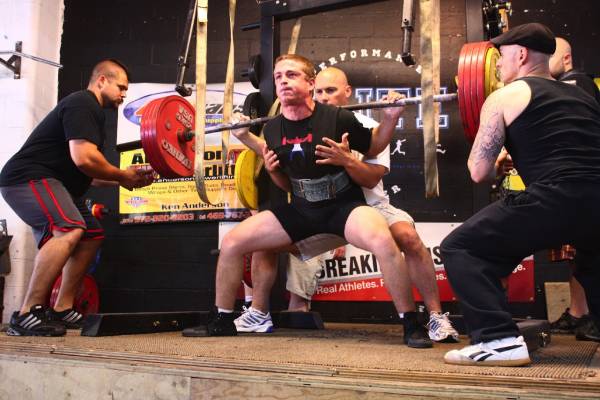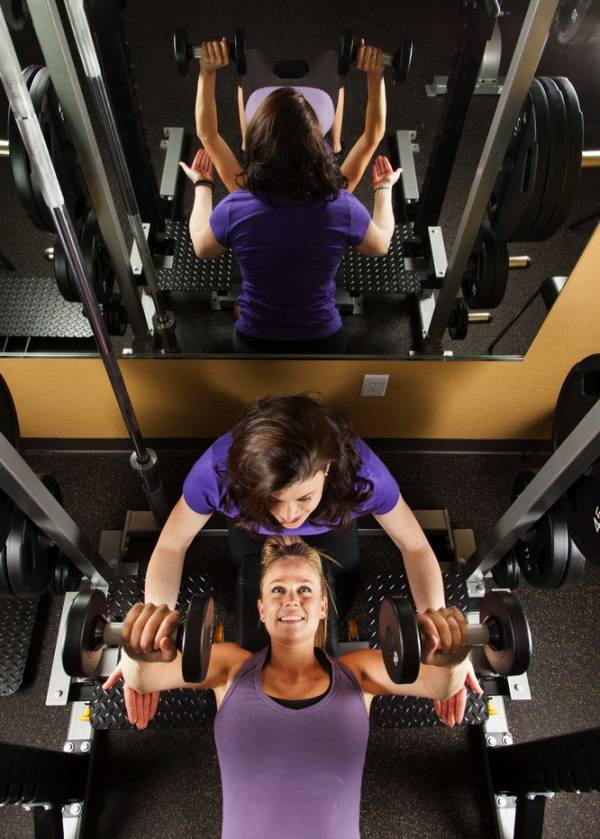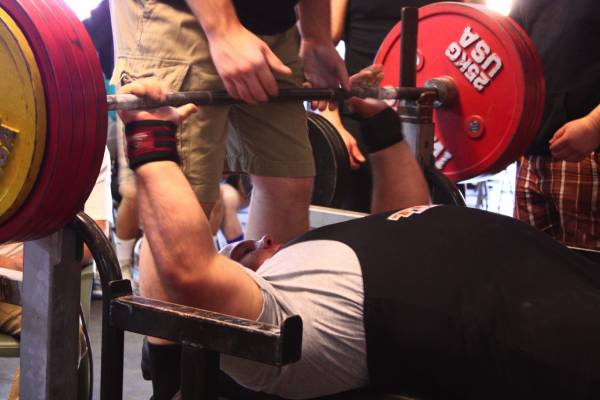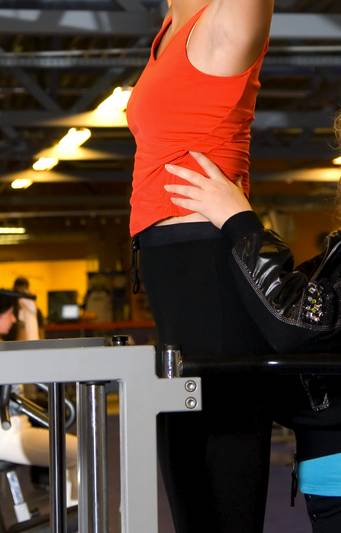Before we begin, there are a few things to note on spotting. If your lifter cannot get the weight up at least mostly by themselves, he or she should back off, lighten the load, and work up from there. When pride takes over and the weight is too heavy, form and technique will break down and this leaves the lifter highly prone to injury.
It is not beneficial for strength building when proper form is neglected. It is important to concentrate on technique first (even with lighter weights) in order to build, fire, and strengthen the correct muscles necessary for heavier weights and to stay injury free. Smart lifters and good coaches are far more concerned with (or at least they should be) a proper and technically-sound lift than a dangerous desperate effort to “just get it up” any way they can. We can push a lifter safely and without sacrificing form by using proper spotting techniques.
Spot-On
The idea behind spotting is not to lift the weight for the lifter (that defeats the purpose completely,) but rather to be there to support proper form as you allow your lifter to “struggle” through weights that he or she might not be able to manage safely alone. As you spot, let the lifter fight through the “sticky spots” a bit and do not lift anything for him or her. You can assist when he or she actually does get stuck or slow a great deal in several ways. This relationship between the spotter and the lifter is in fact is the biggest benefit to the lifter’s strength building and is your biggest role.
Nonetheless, as a spotter it is important to be prepared for anything. If he or she fails or begins to fail and you cannot spot any further, bail. Always bail. Never try to save the bar, just your lifter and yourself.
The Spotter Stance
Spotters should use a widened split stance to create a larger base of stability. To do this, you set one foot in front and the other one staggered behind. Maintain a tight and upright trunk and core, and adjust your hand placement according to the lift. Make sure both you and your lifter know what you are about to do by establishing the rep range and the goal ahead of time.
Spotting Techniques and Rules
1. Back Squat
 There are two ways to spot a back squat. You can spot by the sides of the bar (one person on each end and outside of the rack) or from behind the athlete. I am a huge proponent of spotting from behind the lifter. In addition, squat racks with sidebars are a great benefit with and without a spotter as they catch any failed rep or falling bar and thus save the spotter and the lifter from injury.
There are two ways to spot a back squat. You can spot by the sides of the bar (one person on each end and outside of the rack) or from behind the athlete. I am a huge proponent of spotting from behind the lifter. In addition, squat racks with sidebars are a great benefit with and without a spotter as they catch any failed rep or falling bar and thus save the spotter and the lifter from injury.
Let the lifter back away from the rack and settle into the starting stance or set up. Stand behind your lifter and follow him or her down (in a similar motion as the squat itself). Have your hands up and under the armpits and on or near the chest (not touching unless necessary). Your role here is to help the lifter maintain a raised chest as the tendency when fatigue sets in is to collapse the core or trunk forward over the quads. By your guiding that chest up, the lifter has the advantage of maintaining form while still fighting for those last important strength-building reps. Also, help the lifter re-rack the weight by guiding the bar back with him or her into the proper rack position and securing it into place.
2. Dumbbell Press (Overhead or Bench)
 The proper spot here is to rest your hands right under the elbows. I see many people try to help the lifter by grabbing on to his or her wrists or even the weights themselves. You can slide your hands up along the outside, from elbows to wrists, to guide the wrists at the top – but never grab the wrists of the lifter.
The proper spot here is to rest your hands right under the elbows. I see many people try to help the lifter by grabbing on to his or her wrists or even the weights themselves. You can slide your hands up along the outside, from elbows to wrists, to guide the wrists at the top – but never grab the wrists of the lifter.
There is also no need to touch the elbows unless your lifter is gassed and there is nothing more to lose except for form. You can lightly guide the motion, but allow the lifter to do most of the work. At failure, you can assist by pressing the elbows up from underneath. Be ready to move out of the way when it comes to spotting dumbbells, as these are often best dropped after the final rep and your feet do not need to be their cushioning.
3. Bench Press
Spotters, stand behind your lifter here. You might want to ask him or her first if they need a “lift-off” (an assist lifting the bar off the rack before the first rep begins). Many lifters like to save energy and strength for the lift itself rather than the un-racking of heavier weight.
 From there, let the athlete lift and when you see him or her begin to struggle, the proper spot to use is placing fingertips or palms of the hands under the bar. If you know you might need to pull the bar for (or off) your lifter when using heavier weights, a reverse grip (one overhand and one underhand) is a solid and secure grip. Spacing of the hands should be just inside (towards the middle of the bar) of your lifter’s hands. You do not need to go so low with the movement as to touch the lifter’s chest at the bottom, but be there as he or she begins to press up.
From there, let the athlete lift and when you see him or her begin to struggle, the proper spot to use is placing fingertips or palms of the hands under the bar. If you know you might need to pull the bar for (or off) your lifter when using heavier weights, a reverse grip (one overhand and one underhand) is a solid and secure grip. Spacing of the hands should be just inside (towards the middle of the bar) of your lifter’s hands. You do not need to go so low with the movement as to touch the lifter’s chest at the bottom, but be there as he or she begins to press up.
Strength is built by fighting through these sticky spots – and we all have them. Often a little assistance (even the slightest) will allow the struggling lifter to get unstuck momentarily and thus allow him or her to continue. Most of the time, once we push through these spots, we find that we have more in the tank. You can help your lifter dig themselves out with even just a little guidance, but always be ready to give more. Don’t go away – always stay with the lifter until the bar is re-racked safely.
4. Pull Ups
 I talk about this a lot because spotting pull ups is done so poorly and so often almost everywhere I go. Spotting someone during pull-ups by the foot is not helpful – for anyone. Bands aren’t ideal either and especially not when you actually have someone in the gym who can help you. Put your training partners to work and get the most out of your full-range, full-body, proper pull up. (And stay posted for my next article covering everything you could ever want to know about learning and improving pull-ups.)
I talk about this a lot because spotting pull ups is done so poorly and so often almost everywhere I go. Spotting someone during pull-ups by the foot is not helpful – for anyone. Bands aren’t ideal either and especially not when you actually have someone in the gym who can help you. Put your training partners to work and get the most out of your full-range, full-body, proper pull up. (And stay posted for my next article covering everything you could ever want to know about learning and improving pull-ups.)
The proper spotting technique here is spotting by the hips or by the trunk and obliques. The same methods apply here as in spotting other movements, as you want to give your athlete the minimal help possible. Sometimes as a spotter, you are just there to keep the athlete moving more than anything. Having a person instead of a band or a machine is helpful as a spotter can judge the athlete’s fatigue and adjust assistance accordingly. Your athlete might be able to knock out one or two alone, but might fatigue around the third or fourth rep. So that is where you can help out a little more and “take a little weight off.” Still though, let the athlete do as much of the pull as possible on his or her own.
5. What Never to Spot: Power Exercises
I suppose this goes without saying, but I will say it here anyway. The great thing about spotting the exercises we have discussed is that they help build many foundations (strength especially) essential for performing power exercises. The two Olympic lifts are a great example (the clean and jerk and the snatch) of instances where no spotter can or should be used. Build up the fundamental and foundational strength, technique, and skills and then apply them to power exercises and other athletic movements that meant are to be done unassisted.
Photo 1 courtesy of Katie Chasey and RXBound.
Photos 2 & 4 courtesy of Becca Borawski.
Photos 3 & 5 courtesy of Shutterstock.






